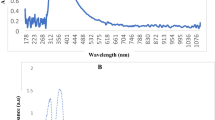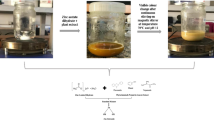Abstract
Black leaf spot of Brassica species is caused by a foliar pathogen Alternaria brassicicola (A. brassicicola), the noxious killer of mustard, cabbage, and cauliflower crops. The current investigation involved the synthesis of copper oxide nanoparticles (CuO NPs) from potential strain of Trichoderma harzianum (T. harzianum). Characterization of CuO NPs was performed by UV–vis, FTIR, XRD, SEM-EDX, and HR-TEM studies. UV–visible spectra showed an absorption peak at 275 nm. FTIR study revealed the presence of N–H bonds which could be due to the presence of enzymes and secondary metabolites released in the filtrate of T. harzianum. SEM and HR-TEM revealed the cube shape CuO NPs formed and average particle size was in the range of 31–45 nm. Poisoned food technique was used to check the antifungal efficacy of CuO NPs against A. brassicicola at various concentrations (0.025, 0.050, 0.1, and 0.15 mg/mL). In vitro assays carried on potato dextrose agar showed maximum antifungal activity at 0.15 mg/mL. The control sample have cylindrical and oblong shape conidia, while transverse septation was 2–4 in untreated population. The lower concentrations of CuO NPs (0.025 and 0.050 mg/mL) caused malformed spherical shape conidia with excessive septation, while its higher concentrations (0.1 and 0.15 mg/mL) leads to viability loss in fungal culture. Results indicated that a higher concentration of CuO NPs serve as an effective biocidal concentration for the control of phytopathogens.




Similar content being viewed by others
Data Availability
The data presented in this study are available on request from the corresponding author.
Code Availability
Not applicable.
Abbreviations
- CuO NPs:
-
Copper oxide nanoparticles
- A. brassicicola :
-
Alternaria brassicicola
- T. harzianum :
-
Trichoderma harzianum
- ppm:
-
Parts per million
- PDA:
-
Potato dextrose agar
- PDB:
-
Potato dextrose broth
References
Chattopadhyay C (2008) Management of diseases of rapeseed mustard with special reference to Indian conditions. In: Kumar A, Chauhan JS, Chattopadhyay C (eds) Sustainable production of oilseeds: rapeseed-mustard technology. Agrotech Publishing Academy, Udaipur, pp 364–388
Michereff SJ, Noronha MA, Xavier Filha MSM, Reis CMPSA (2012) Survey and prevalence of species causing Alternaria leaf spot on brassica species in Pernambuco. Hortic Bras 30:345–348. https://doi.org/10.1590/s0102-05362012000200027
Basavaraj K, Rathi AS, Gurav NP, Rakesh P, Kumar A (2020) Evaluation of selected fungicides for the management of white rust of Indian mustard. J Oilseeds Res 37(2):99–103
Gajbhiye M, Kesharwani J, Ingle A, Gade A, Rai M (2009) Fungus-mediated synthesis of silver nanoparticles and their activity against pathogenic fungi in combination with fluconazole. Nanomedicine 5(4):382–386. https://doi.org/10.1016/j.nano.2009.06.005
Elmer WH, De La Torre-Roche R, Pagano L, Majumdar S, Zuverza-Mena N, Dimpka C, Gardea-Torresdey J, White W (2018) Effect of metalloid and metallic oxide nanoparticles on Fusarium wilt of watermelon. Plant Dis 102:1394–1401. https://doi.org/10.1094/PDIS-11-17-1707-RE
Kanhed P, Birla S, Gaikwad S, Gade A, Seabra AB, Rubilar DN, Rai M (2014) In vitro antifungal efficacy of copper nanoparticles against selected crop pathogenic fungi. Mater Lett 115:13–17. https://doi.org/10.1016/j.matlet.2013.10.011
Borkow G, Gabbay J (2009) Copper, an ancient remedy returning to fight microbial, fungal and viral infections. Curr Chem Biol 3(3):272–278. https://doi.org/10.2174/2212796810903030272
Kumari M, Giri VP, Pandey S, Kumar M, Katiyar R, Nautiyal CS, Mishra A (2019) An insight into the mechanism of antifungal activity of biogenic nanoparticles than their chemical counterparts. Pestic Biochem Physiol 157:45–52. https://doi.org/10.1016/j.pestbp.2019.03.005
Malandrakis AA, Kavroulakis N, Chrysikopoulos CV (2019) Use of copper, silver and zinc nanoparticles against foliar and soil-borne plant pathogens. Sci Total Environ 670:292–299. https://doi.org/10.1016/j.scitotenv.2019.03.210
Elmer WH, White JC (2016) The use of metallic oxide nanoparticles to enhance growth of tomatoes and eggplants in disease infested soil or soilless medium. Environ Sci Nano 3(05):1072–1079. https://doi.org/10.1039/c6en00146g
Gaba S, Varma A, Goel A (2021) Protective and curative activity of biogenic copper oxide nanoparticles against Alternaria blight disease in oilseed crops: a review. J Plant Dis Prot. https://doi.org/10.1007/s41348-021-00555-7
Consolo VF, Torres-Nicolini A, Alvarez VA (2020) Mycosynthetized Ag, CuO and ZnO nanoparticles from a promising Trichoderma harzianum strain and their antifungal potential against important phytopathogens. Sci Rep 10:20499. https://doi.org/10.1038/s41598-020-77294-6
Das PE, Abu-Yousef IA, Majdalawieh AF, Narasimhan S, Poltronieri P (2020) Green synthesis of encapsulated copper nanoparticles using a hydroalcoholic extract of Moringa oleifera leaves and assessment of their antioxidant and antimicrobial activities. Molecules 25(3):555. https://doi.org/10.3390/molecules25030555
El-Trass A, ElShamy H, El-Mehasseb I, El-Kemary M (2012) CuO nanoparticles: synthesis, characterization, optical properties and interaction with amino acids. Appl Surf Sci 258(7):2997–3001. https://doi.org/10.1016/j.apsusc.2011.11.025
Valodkar M, Jadeja RN, Thounaojam MC, Devkar RV, Thakore S (2011) Biocompatible synthesis of peptide capped copper nanoparticles and their biological effect on tumor cells. Mater Chem Phys 128:83–89
Sanjini NS, Winston B, Velmathi S (2017) Effect of precursors on the synthesis of CuO nanoparticles under microwave for photocatalytic activity towards methylene blue and rhodamine B dyes. J Nanosci Nanotechnol 17(1):495–501. https://doi.org/10.1166/jnn.2017.11785
Attia MS, El-Sayyad GS, Abd Elkodous M, El-Batal AI (2020) The effective antagonistic potential of plant growth-promoting rhizobacteria against Alternaria solani-causing early blight disease in tomato plant. Sci Hortic 266:109289. https://doi.org/10.1016/j.scienta.2020.109289
Applerot G, Lellouche J, Lipovsky A, Nitzan Y, Lubart R, Gedanken A, Banin E (2012) Understanding the antibacterial mechanism of Cuo nanoparticles: revealing the route of induced oxidative stress. Small 8(21):3326–3337. https://doi.org/10.1002/smll.201200772
Ohara T, Tsuge T (2004) FoSTUA encoding a basic helix-loop-helix protein, differentially regulates development of three kinds of asexual spores, macroconidia, microconidia, and chlamydospores, in the fungal plant pathogen Fusarium oxysporum. Eukaryot Cell 3(6):1412–1422. https://doi.org/10.1128/ec.3.6.1412-1422.2004
Fujiwara K, Iida Y, Iwai T, Aoyama C, Inukai R, Ando A, Ogawa J, Ohnishi J, Terami F, Takano M, Shinohara M (2013) The rhizosphere microbial community in a multiple parallel mineralization system suppresses the pathogenic fungus Fusarium oxysporum. Microbiol Open 2(6):997–1009. https://doi.org/10.1002/mbo3.140
Karlsson HL, Cronholm P, Gustafsson J, Moller L (2008) Copper oxide nanoparticles are highly toxic: a comparison between metal oxide nanoparticles and carbon nanotubes. Chem Res Toxicol 21(9):1726–1732
Yoon KY, Byeon JH, Park JH, Hwang J (2007) Susceptibility constants of Escherichia coli and Bacillus subtilis to silver and copper nanoparticles. Sci Total Environ 373(2–3):572–575
Acknowledgements
We would like to thank Professor (Dr.) Ajit Varma (Distinguished Scientist and Professor of Eminence, Amity Institute of Microbial Technology) for providing us lab facility for the completion of this work
Funding
The authors have not disclosed any funding.
Author information
Authors and Affiliations
Contributions
SG: sample collection, lab experiments, data analysis, and writing first draft of the manuscript. AV, AG, RP: conceptualization, methodology, visualization, investigation. AG, RP: supervision and revision of the manuscript. All authors have read and approved the final manuscript.
Corresponding authors
Ethics declarations
Conflict of interest
All authors declare that they have no conflict of interest.
Consent to Participate
We Dr. Arti Goel and Dr. Ram Prasad give the consent to participate in Current Microbiology.
Consent for Publication
We Dr. Arti Goel and Dr. Ram Prasad give the consent to use the information to publish in Current Microbiology.
Informed Consent
Informed consent was obtained from all subjects involved in the study.
Research Involving Human Participants and/or Animals
No human or animal involvement in the study.
Additional information
Publisher's Note
Springer Nature remains neutral with regard to jurisdictional claims in published maps and institutional affiliations.
Supplementary Information
Below is the link to the electronic supplementary material.
Rights and permissions
About this article
Cite this article
Gaba, S., Varma, A., Prasad, R. et al. Exploring the Impact of Bioformulated Copper Oxide Nanoparticles on Cytomorphology of Alternaria brassicicola. Curr Microbiol 79, 244 (2022). https://doi.org/10.1007/s00284-022-02927-0
Received:
Accepted:
Published:
DOI: https://doi.org/10.1007/s00284-022-02927-0




